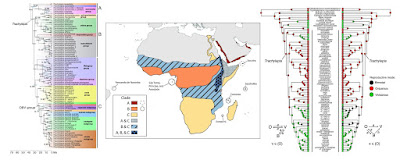 |
| Phylogeny of Trachylepis
in Weinell, Branch, Colston, et al., 2019.
|
Highlights
• Species-level phylogeny of Trachylepis inferred.
• Oviparity inferred as ancestral reproductive condition for Trachylepis.
• Multiple reproductive mode transitions supported within Trachylepis.
• Best-fit model supports controversial viviparity to oviparity transitions.
Abstract
Trachylepis (Mabuyinae) includes 80 species of fully-limbed skinks found primarily in Africa and Madagascar, but a robust species-level phylogeny for this genus is lacking and this impedes studies on a wide-range of topics from biogeography to character evolution. Trachylepis and its close relatives (which together form the Mabuya group or Mabuyinae) are notable in that they have undergone multiple transitions and remarkable specializations in their reproductive modes. A Trachylepis phylogeny will be particularly useful for investigating reproductive evolution, because it includes species that exhibit oviparity, viviparity, and bimodal parity (species with both oviparous and viviparous populations). We sequenced DNA at four mitochondrial and five nuclear loci for 67 (84% of) Trachylepis species to infer a phylogeny for this genus. We performed stochastic character mapping of parity mode under a variety of parity mode transition models to infer ancestral parity mode states and the number and type of parity mode transitions. We recovered a strongly supported phylogeny of Trachylepis that is generally consistent with earlier phylogenetic studies. The best-fit model of reproductive mode evolution supports an oviparous ancestor for Trachylepis, and supports at least three viviparity to oviparity transitions. We compared parity mode evolution under the overall best-fit model (no constraints on parity mode transitions) to the best-fit model among the subset of models that assume viviparity to oviparity transitions are impossible. Our results support a model of reproductive evolution that allows for reversibility from viviparity to oviparity, a process that is not generally accepted. Alternatively, the best-fit model of evolution among the set of models that eliminate reversals from viviparity to oviparity suggests that bimodal reproduction may have persisted for millions of years within multiple lineages.
Keywords: Dollo’s law, Viviparity, Oviparity, Bimodal parity, Stochastic character mapping, Squamata
Jeffrey L. Weinell, William R. Branch, Timothy J. Colston, Todd R. Jackman, Arianna Kuhn, Werner Conradie and Aaron M. Bauer. 2019. A Species-level Phylogeny of Trachylepis (Scincidae: Mabuyinae) provides insight into their Reproductive Mode Evolution. Molecular Phylogenetics and Evolution. 136; 183-195. DOI: 10.1016/j.ympev.2019.04.002

